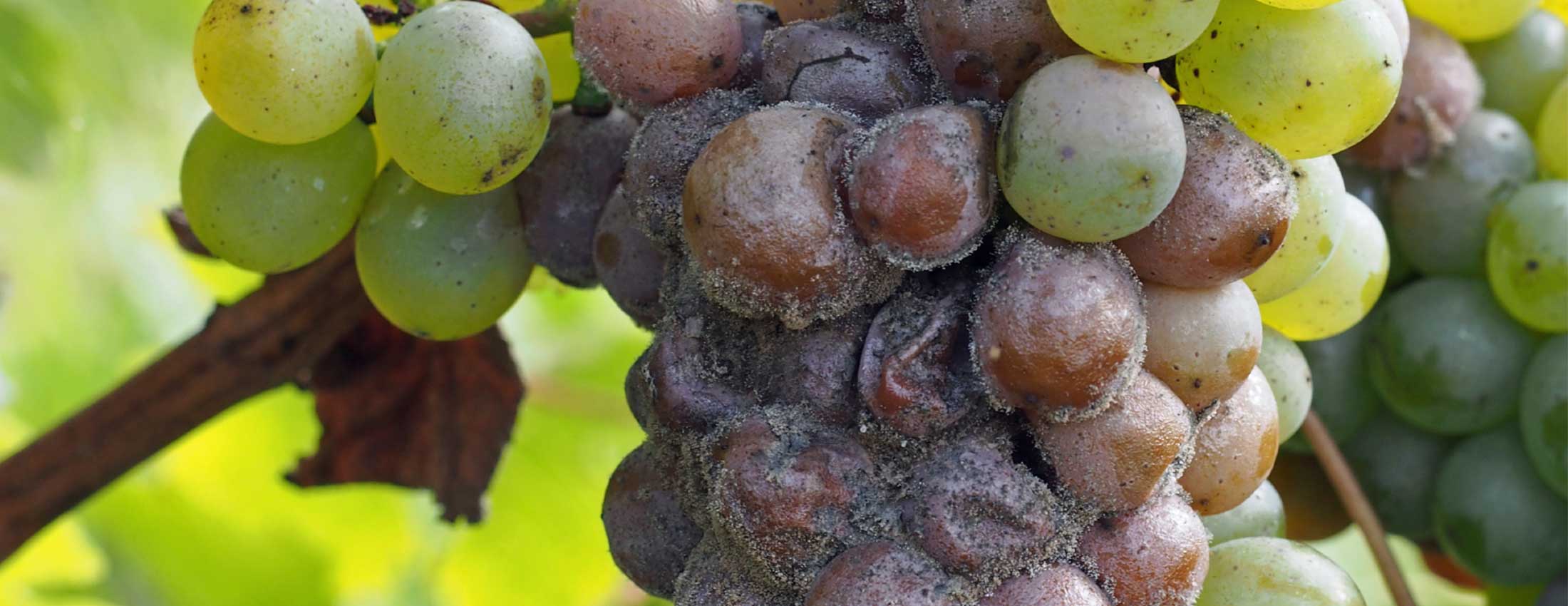Helping Plants to Fight their Own Battles

An article by Sonja Burger.
“Steer clear of the ‘there’s a problem – let’s-throw-a-chemical-on-it mentality’,” warns Graeme Sait, Australian expert on high-production sustainable agriculture. Sait, the CEO of Nutri-Tech Solutions in Australia, recently spoke to farmers in Paarl about alternative methods to control disease and pests.
In vineyards across the world an unseen battle plays itself out every year. A Botrytis cinerea spore lands on a grape vine. The fungus inadvertently releases its signature protein, its natural calling card. Foliar receptors in the grape vine pick up this calling card and bind to the signature protein, setting off a cascade of biochemical responses. One of the responses is the formation of a flavonoid called stilbene. The function of the stilbene is to block the destructive enzyme the Botrytis fungus releases to damage the cell walls of the fruit. Unwittingly, but fortunately for us, the natural stilbenes that the plant synthesised in its attempt to protect itself against the invasion by Botrytis fungus are finally expressed as the flavour component that gives dessert wine some of its complex, rich flavours.
Natural defense systems
Graeme Sait explains that plants, like humans, have immune systems that respond to external cues. These external cues prompt a plethora of biochemical responses that trigger the expression of hundreds of genes. The genes stimulate the production of biochemicals called phyto-chemicals that, amongst other things, actively inhibit, deter or kill invading diseases and pests. The response takes only minutes.
“When humans use chemical pesticides to control pests and diseases, however, the rich suite of biological compounds that the plant would have naturally synthesized in order to protect itself, are not produced,” says Sait, “Consequently, flavor, nutritional and medicinal qualities in the plant are reduced. The beneficial phyto-chemicals are replaced by potentially toxic man-made chemicals. By throwing chemicals such as synthetic pesticides at plants we are essentially restricting the full expression of potential in those plants.”
Biochemical Weapons
Some of the biochemicals that plants synthesize when they are systemically induced:
Flavonoids, produced to deter pathogens. Flavonoids have anti-oxidant qualities, e.g. resveratrol in grapes is highly beneficial to the human immune system.
Tannins, produced for UV protection and to deter feeding by insects and herbivores.
Phytoalexins are produced with strong anti-microbial activity and accumulate around sites of infection. Phytoalexins are highly fungicidal.
Jasmonates signal and stimulate the production enzymes that inhibit insect digestion. They are also known to be fungicidal and highly unpalatable to insects.
Inducing Systemic Resistance
Sait says activating the plant’s natural resistance through a process called ISR (Induced Systemic Resistance) provides one alternative to chemical use. This alternative offers an effective method of achieving quality without reducing yield.
Sait cites an example of Induced Systemic Resistance in tomatoes. Fusarium wilt in tomatoes, caused by the soil-inhabiting fungus Fusarium oxysporum, often infects and damages mature tomato plants. However, research has shown that treating the tomato plants with Bacillus subtilis can induce systemic resistance. Bacillus subtilis is part of a group of microbes known as plant growth-promoting rhizobacter or PGPR. Bacillus subtilis produces probiotic substances that induce systemic resistance in the tomato. When the inoculated plant is planted in soil infected with Fusarium oxysporum, the plant synthesizes biochemicals that discourage the fungus.
Bacillus subtilis is not the only non-pathogenic organism or biochemical stimulus that can trick a plant into believing it is under attack. Kelp, for example, contains cytokinins that are involved in ISR. The soil can also be inoculated with resistance-inducing microbes such as Trichoderma harzianum. Trichoderma species are hyperparasites. They produce enzymes that collapse, shrink and digest host hyphaes – the threadlike cells of fungi. Trichoderma also produce water-soluble, diffusible antibiotics as another measure to counter fungal parasites and pathogens. Recent research has shown Trichoderma can help to control the egg and larval stages of root-knot nematodes. Some farmers in South Africa use Trichoderma very effectively for nematode control in potato crops.
Compost teas, which are packed with a variety of resistance-inducing substances, offer another sustainable way to fight a variety of diseases. Depending on the specific recipe, compost teas have been used to combat Phytophthora, Fusarium, Botrytis, mildew, mold and scabs.
Entomopathogenics
Entomopathogenic (insect-killing) fungi provide an additional arrow in the farmer’s Integrated Pest Management quiver. These fungi are insect-fighting superheroes. Metarhizium anisopliae, Verticillium lecanii and Beauveria bassiana, for example, enter the insect’s orifices and feed off the insect’s internal organs, killing it within 4 to 7 days. Graeme Sait says trials done by the Australian CSIRO with Metarhizium proved very effective against locusts. 93% control was achieved at a cost of less than AUD$10 per hectare.
Another species of Metarhizium has been registered for cane grub control in Australia. Insects that have been reported to be susceptible to this species are all soft-bodied bugs, beetles, grasshoppers, soil grubs and thrips. Sait points out, though, that this specific form of control is climate dependent and is only effective between 16 and 30°C at humidity levels above 70%.
Sait’s company, Nutri-Tech Solutions, has developed a product called Nutri-Life Myco-Force™, which contains bio-balancing entomopathogenic fungi and which can be used on cotton, sugarcane, oil seeds, legumes, vegetables, orchard crops, grapes and cereals. “The product is odourless and non-toxic to humans, animals and plants. It can be used up to harvest and is based upon naturally occurring fungi,” he explains.
Pheromones
Sait says an ever-increasing range of pheromones is being commercialized as part of sustainable pest management solutions. Pheromones are chemical substances secreted by some animals (especially insects) that influence the physiology or behaviour of other animals of the same species. Sexual behaviour, for example, is often triggered by pheromones.
“Pheromones can be considered a chemical control option, but unlike insecticides that rely on chemicals making contact with the insects and killing them, pheromones are gaseous insect stimulants,” Sait explains. A fruit fly bait called Fly-Bye™, for example, attracts and drowns male fruit flies, who hatch a week before the females. When the females hatch, there are very few males left and the reproductive cycle is interrupted.
“Most pheromones tend to be species-specific, even genus-specific, which is ideal in an IPM system,” says Sait.
Beneficial Insects
Farmers should not underestimate the influence of beneficial insects. They come in all shapes and sizes, ranging from large assassin bugs and lacewings to microscopic wasps. “Beneficials are often not readily detected because they do not tend to leave physical symptoms of their presence and they are often very mobile,” Sait explains.
There is wisdom in stimulating the numbers of naturally occurring beneficial insects. Planting refuge crops as inter-row cover creates a natural hiding and breeding place for the beneficials. Fennel, for example, attracts large populations of beneficial ladybirds. Planting them between and at the end of vineyard rows attracts the ladybirds, who eventually move into the vines themselves and help to control pests. In the citrus industry inter-row covers of natural grasses and weeds reduces dust, which would normally inhibit beneficial insects from controlling scale insects.
Cultural strategies
Cultural strategies can also contribute to pest management. “There is an ever-evolving range of cultural strategies that can be used to manage insect pests. Many are based on transferring observations from nature to targeted uses,” says Sait. In Cuba, for example, farmers started using yellow paint tins filled with axle grease to trap insects. The insects are naturally attracted to yellow.
Wrapping cardboard around tree trunks during tree dormancy provides an imitation of the rough bark where insects hide when they overwinter. When the insects have colonised the cardboard, it can be removed and burnt and the pest along with it. Weevils that invade apple trees and that often hide in protected places near or in the orchard can be removed in this way, for instance.
The Benefits of IPM
Sait concludes, “The benefits of pest management solutions that cut down on dangerous chemicals are legion: slower development of resistance to pesticides, reduced health risk to spray operators, reduced chemical contamination of food and the environment and reduced dependence on expensive chemicals.”
 Sonja Burger is an award-winning freelance writer whose first love is education. She writes about topics that fire her passion or spark her imagination and advocates for issues that are close to her heart. She has written for a wide variety of magazines and newspapers in South Africa about topics as diverse as sustainable farming, biodynamic winemaking, the carbon market, French culinary traditions and the role of mitochondrial DNA in tracing maternal lines. Sonja is also a co-author of two of South Africa’s most popular English textbook series – English in Context and Spot On.
Sonja Burger is an award-winning freelance writer whose first love is education. She writes about topics that fire her passion or spark her imagination and advocates for issues that are close to her heart. She has written for a wide variety of magazines and newspapers in South Africa about topics as diverse as sustainable farming, biodynamic winemaking, the carbon market, French culinary traditions and the role of mitochondrial DNA in tracing maternal lines. Sonja is also a co-author of two of South Africa’s most popular English textbook series – English in Context and Spot On.
